Taking a break from mini painting to build/paint some objective markers for my table. Lockers and Tech Pods down. These are from Losblock.
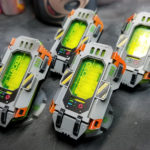 |
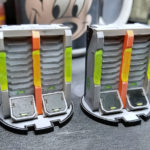 |
Shawn G. (SoI)
Taking a break from mini painting to build/paint some objective markers for my table. Lockers and Tech Pods down. These are from Losblock.
 |
 |
Shawn G. (SoI)
I think I’m getting my painting legs back!
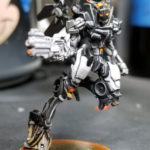 |
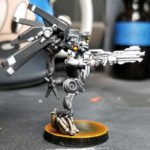 |
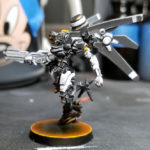 |
The Garuda has detail all over the place and I wanted to stick to my darker theme without using too much white. I think I found a nice balance.
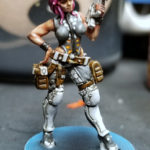 |
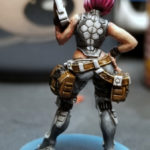 |
The Dactlys has been calling me to paint her for months now and I finally submitted about 10pm last night after finishing the Garuda. I love the detail of this mini and I was itching at another shot at painting skin tones. She would not let me put her down until she was complete (about 2am) and I’m glad I finished. I think this is the best painted Infinity mini I have done to date.
More to come as I progress.
ShawnG (SoI)
Greetifications!
I’m currently working on a new paint project for Infinity. I have not painted anything serious since my Yu Jing mining table back at the start of the year. I’ve decided to buckle down and start another paint project and this time it’s Aleph!
Color Scheme:
For the bases I’m trying something new. Basing has never been one of my strong points (look at my Arkhan Tomb Kings). I’m trying a style I’ve never seen before that my friend Robert suggested. First of all all the bases will blank save for a airbrushed tone. All of my army will be broken into color types. Here are the shades I’ve chosen so far.
I have a pretty damn cool idea for a display when all this is finished but I need to get there first.
First model up is the test model Myrmidon Doctor-Officer Machaon. I like how this guy came out. The scheme gels with me and uses my favorite colors. ‘m forcing myself to get good with faces. While not perfect, I managed a semblance of 5 o’clock shadow on Machaon. Sorry for the image quality. I really need to get/build a photo light box.
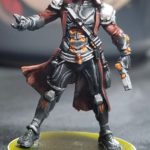 |
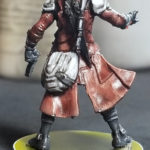 |
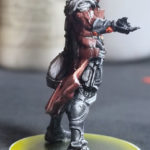 |
Next up is one of my line troops a Dakini Tactbot. No duster to paint on this mini so I didn’t have to paint leather. Brought the white theme from the shoulders on Machaon all the way down the arms. I think I will keep that in the scheme. Lighting came out half decent as well. Need more practice there.These models are a right pain to put together. I hope they update the kit soon. Need to be on the level of sexiness that is the Garuda.
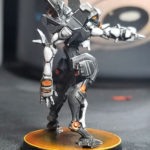 |
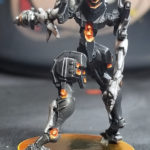 |
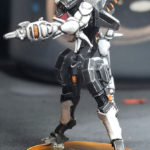 |
Here are the models from the previous scheme I was attempting. I think I will keep these as experiments in color and for display purposes. I like the scheme and it’s colors. It has nice contrast, but was not fun to pain. Didn’t gel with me. These models also show off the basing design I’m trying out. I believe it will really begin to stand out when I have more then 4 finished.
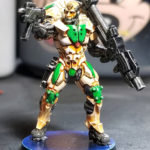 |
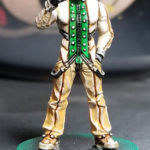 |
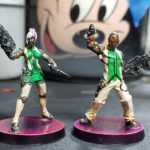 |
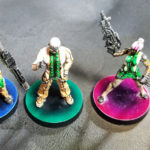 |
That’s all I got. More to come as I progress.
Shawn G. (SoI)
Salutations!
I have been receiving a great deal of requests for a tutorial on how I did the weathering on my Wild Lands table. Here’s a quick rundown:
I painted this terrain set using inks primarily. They are perfect for painting MDF terrain for two reasons; first, they go through an airbrush with no need for dilution. Second, the MDF is porous and absorbs the paint/ink cutting drying time.
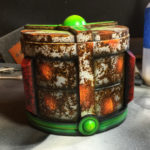 |
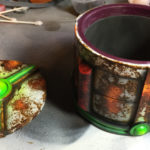 |
Color’s used:
Daller Rowney – Burnt Umber 223
Liquitex Ink – Carbon Black
Citadel (GW) – Mournfang Brown
Vallejo Game Color – Hot Orange 72009
Vallejo Model Color – Light Orange 70911
Vallejo Surface Primer – Gray
Materials Used:
Egg foam
I currently don’t have any new terrain pieces prepped for painting so I’m using a cast of the dice box I made for my Necrons a few years ago. It was sitting around and looked like it would make a pretty cool cistern for my table.
Step I – The box was primed gray. Since the cup is made out of resin it lacks the nice quick drying quality of MDF, I used a hairdryer to speed up the process. In fact I did the same thing with the MDF terrain. Really helps to keep stuff rolling.
Step II – All the cracks & crevices were airbrushed in black. It looks heavy at the start but once you start weathering you’ll be glad for it.
Step III – I took a piece of egg foam I had sitting around and cut it into pieces about 1 by 1.5 inches wide. Then, using my fingers I pulled plugs out of the flat side to make the surface uneven. It’s important to pull the edges as you don’t want a ‘square’ sides on the sponge. I like using the egg foam for this process as the ridged side have little finger holds.
Step IV – Break out the burnt umber. I used condiment cups for this but a palate is fine. Dip the textured end in the ink and place a few practice dabs on your palate to get full coverage on the sponge. These practice dabs also help to control the amount of ink on the sponge as it can be heavier then you expect and you don’t want to make any mistakes on your piece.
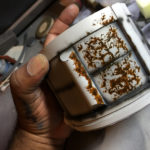 |
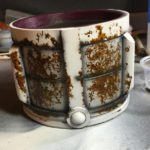 |
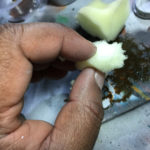 |
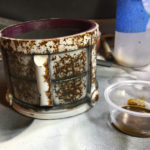 |
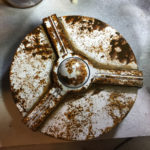 |
Step V – Lightly dab the surface you want weathered. I turn the sponge around to add to the randomness of the ‘splatter’ look. As this surface is not porous, I had to use the hairdryer between panels. I decided to go with a heavy rust/corrosion look on the cup. I went lighter on the buildings.
After the large panels were done I noticed I had a great deal of ‘white space’ along the edges. I ripped up a smaller sponge and used that to get ink in the corners/edges as that’s where rust would accumulate first. The smaller sponge was also used to color the rest of the box and to create some areas where the ink is applied heavily. These heavy splotches are needed for the next step.
Step VI – Rip up an new small piece of sponge. You can also wash the smaller piece you made for the umber phase. Using the Mournfang Brown, add new splotch patches over the umber. You want to aim to cover the areas (not completely) where the umber was heavy as these spaces will represent your rust areas.
Step VII – These last steps go fast. Repeat the process you used for Step VI but this time using the Hot Orange followed by the Light Orange. Cover the brown with patches of orange but again not completely. You want the previous color to show underneath. The key to this phase is to go easy. Less is more.
And that’s it! I painted the rest of the cup with some glow effects and called it a day. The weathering process took about 10-15 minutes to complete and 20-25 minutes for the whole paint job. You’ll kick yourself at how easy this is to do in the end. Feel free to shoot me any questions.
Shawn G. (SoI)